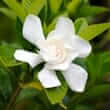Background
- The gardenia family (Rubiaceae) contains 10,200 species. The most commonly used species in medicine is Gardenia jasminoides (Cape jasmine).
- Gardenia has been used in Asian traditional medicine for centuries. It is believed to have sedative, laxative, and fever-reducing effects, and it has also been used to treat bacterial infections, diabetes, liver disease, gallbladder disease, and some skin disorders. However, more human clinical trials are needed to confirm these effects.
References
- Achliya GS, Wadodkar SG, and Dorle AK. Evaluation of sedative and anticonvulsant activities of Unmadnashak Ghrita. J Ethnopharmacol. 2004;94(1):77-83. View Abstract
- Chou CC, Pan SL, Teng CM, et al. Pharmacological evaluation of several major ingredients of Chinese herbal medicines in human hepatoma Hep3B cells. Eur.J Pharm Sci 2003;19(5):403-412. View Abstract
- He, J. and Bai, J. Y. Investigation on clinical curative effect of oral YIN-ZHI-HUANG preparation (Herba Artemisiae Scopariae, Fructus Gardeniae, etc.) for icterus hepatitis. Chinese Traditional Chinese Medicine 1995;17(7):23-24.
- Kim Y, So HS, Youn MJ, et.al. Anti-inflammatory effect of Sasim extracts in PHA-stimulated THP-1 and peripheral blood mononuclear cells from cerebral infarction patients. Journal of Ethnopharmacology (Ireland) 2007;112:32-39.
- Lan WJ, Wang HY, Lan W, et al. Geniposide enhances melanogenesis by stem cell factor/c-Kit signalling in norepinephrine-exposed normal human epidermal melanocyte. Basic Clin Pharmacol Toxicol. 2008;103(1):88-93. View Abstract
- Lee TY, Chang HH, Chen JH, et al. Herb medicine Yin-Chen-Hao-Tang ameliorates hepatic fibrosis in bile duct ligation rats. J Ethnopharmacol. 1-19-2007;109(2):318-324. View Abstract
- Magassouba FB, Diallo A, Kouyate M, et al. Ethnobotanical survey and antibacterial activity of some plants used in Guinean traditional medicine. J Ethnopharmacol. 10-8-2007;114(1):44-53. View Abstract
- Peng CH, Huang CN, and Wang CJ. The anti-tumor effect and mechanisms of action of penta-acetyl geniposide. Curr Cancer Drug Targets. 2005;5(4):299-305. View Abstract
- Sung HW, Huang RN, Huang LL, et al. Feasibility study of a natural crosslinking reagent for biological tissue fixation. J Biomed.Mater.Res 12-15-1998;42(4):560-567. View Abstract
- Villasenor IM. Bioactivities of Iridoids. Anti-Inflammatory & Anti-Allergy Agents in Medicinal Chemistry 2007;6(4):307-314.
- Wen-Jun L, Hai-Yan W, Wei L, et al. Evidence that geniposide abrogates norepinephrine-induced hypopigmentation by the activation of GLP-1R-dependent c-kit receptor signaling in melanocyte. J Ethnopharmacol. 6-19-2008;118(1):154-158. View Abstract
- Yamamoto M and Shoda J. Inchinko-to Agent for liver fibrosis, choleretic agent, hepatoprotectant. Drugs of the Future (Spain) 2005;30:1092-1101.
- Yin J, Wennberg RP, and Miller M. Induction of hepatic bilirubin and drug metabolizing enzymes by individual herbs present in the traditional Chinese medicine, yin zhi huang. Dev.Pharmacol Ther 1993;20(3-4):186-194. View Abstract
- Yotsumoto H, Yanagita T, Yamamoto K, et al. Inhibitory effects of oren-gedoku-to and its components on cholesteryl ester synthesis in cultured human hepatocyte HepG2 cells: evidence from the cultured HepG2 cells and in vitro assay of ACAT. Planta Med 1997;63(2):141-145. View Abstract
- Zhu J, Cai DH, and Rui J. Anti inflammatory and analgesic effects of Cape jasmine (Gardenia jasminoides). Chinese Traditional and Herbal Drugs (China) 2000;31:198-200.







